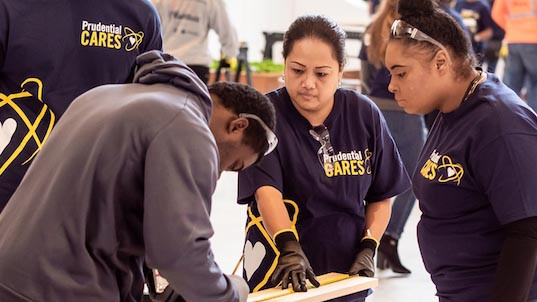 Students of YouthBuild, a Prudential investee, teach Prudential volunteers how to construct garden boxes for local schools. (Image courtesy of Prudential)
Students of YouthBuild, a Prudential investee, teach Prudential volunteers how to construct garden boxes for local schools. (Image courtesy of Prudential)
As vital as it may seem today, the idea that corporations should meet the needs of underserved communities and integrate social good into their DNA—rather than address it separately through philanthropy—is far from common. Indeed, the need to break down the walls between profit and purpose helped spark the impact investing movement.
However, our company, Prudential, was founded in 1875 on the belief that working families from lower-income communities deserve access to the same financial protections as wealthy Americans. Where some saw the industrial class falling behind, our founder, John Dryden, saw unmet market need and an opportunity for the company and its community to succeed together.

Today, we offer a variety of products and services through our business lines, including individual and group life insurance, annuities, retirement-related services, mutual funds, investment management, and real estate services with operations in the United States, Asia, Europe, and Latin America. Our goal of supporting underserved communities remains the same. This drives Prudential to see our culture, products, and services—including impact investments and grants—through the lens of “shared value,” an intentional strategy of bridging the divide between traditionally corporate and traditionally philanthropic partners, toolsets, and activities.
We also recognize that social and economic inequality maps along racial and gender lines, and that tackling these disparities requires a long-term commitment to diversity and inclusion—both internally and externally. Keeping our headquarters in our hometown of Newark, New Jersey, where nearly two-thirds of households live one emergency away from falling into poverty and where one in five are unbanked, is an expression of this sense of purpose and a strong reminder of how much needs to be done.
Organizing for Impact
As I alluded to earlier, corporations in the United States often silo off their organization’s philanthropic function and separate out main business lines from corporate centers. This makes it difficult to communicate a unified view or collaborate across teams.
In committing to diversity and inclusion, Prudential believed it was important to first look within, and build a more integrated and inclusive workplace. I also firmly believed we could go further by combining the best of what we knew from nonprofit work with financial expertise and market efficiency from the corporate side. To build this bridge, we recently merged our human resources function of diversity and inclusion with Prudential’s impact investing, philanthropic giving, and community engagement practices.
This kind of team is unique in financial services. It allows us to see which initiatives have the most impact and align resources behind them. We can also build partnerships with businesses, social enterprises, and nonprofits more flexibly across different business areas, and leverage these relationships worldwide across Prudential’s more than 49,000 employees and millions of customers.
Supporting Capital Managers of Color
The need for accelerated progress on race and gender is acute in financial services. A recent (unpublished) study by Fairview Capital, the largest private equity manager owned by a woman of color, of racial and ethnic representation in private equity found that 78 percent of senior management was white, 20 percent was Asian, and only 1 percent was Latinx or African-American. Under-representation in private equity is also more severe than in other well-compensated professional fields, such as law and medicine. This pattern also holds for gender; the field of asset management has a much lower participation rate by women than other professional fields.
To address these disparities, we’re developing a continuum of initiatives that draw on Prudential’s approach to shared value. One of our tactics is to invest directly in diversity by deploying capital with financial intermediaries founded and run by women and people of color. They include:
-
Committing to inclusive venture capital: Prudential’s impact investment program has an ongoing, $25 million commitment to support the growth of more-inclusive venture capital models that promote diverse investment teams, support underrepresented founders, and invest in business models that address large-scale social challenges. Through this program, we’ve placed capital with the Impact America Fund, Bronze Investments, and Urban Innovation Fund.
- Supporting emerging managers: We commissioned a study in 2016 with the Association of Black Foundation Executives (ABFE) that found that, despite the array of programs foundations support to address inequality around the globe, very few foundations had implemented diverse manager programs within their investment portfolios. Prudential has developed a portfolio of emerging managers and has placed $905 million of our corporate account dollars with minority and woman-owned asset managers, sparking billions in asset growth at participating firms.
- Placing assets with minority and veteran-owned depository institutions and money managers: Since 1987, three-quarters of the nation’s 91 African-American banks have disappeared, as the industry has consolidated in response to changing market conditions. Yet minority depository institutions address the persistent lack of capital and other financial services available to minority communities. Prudential actively places cash deposits and other liquid assets—totaling $47.8 million—with minority depositories, and minority and veteran-owned money managers across the United States.
Developing New, Inclusive Products
According to a survey conducted by The Center for Financial Services Innovation (CFSI), 57 percent of Americans are struggling financially, and 63 percent don’t have enough savings to meet a $500 emergency. Meanwhile, Prudential's 2018 Financial Wellness Census found that women, people of color, and younger generations are the most worried about their financial future. Hispanics are the most worried (58 percent)—a higher percentage than even disabled adults (53 percent).
We therefore continue to ask ourselves: How can we develop new financial services grounded in a genuine understanding of the challenges our customers are facing? And how will Prudential know if our products make a difference? To address these questions and identify scalable, inclusive, market-based solutions, we brought together more than 600 Prudential colleagues, including executives, for our third Inclusive Markets Summit in December 2018. The team selected nonprofit organizations with expertise on these issues, including CFSI and Prosperity Now, to partner with our corporate product development, marketing, and business development teams.
That process of collaboration began two years earlier and seeded several innovative products that have since come to market and are now in pilot phases. One of them provides an after-tax emergency savings option within a 401(k) plan. This option is available to both low- and high-income earners, and allows those facing unanticipated expenses, such as medical care or car repair, to tap into their policies on a short-term basis.
Making Direct Investments in Communities of Color
A third approach addresses structural barriers to economic mobility by investing directly in low-income communities of color. These barriers to mobility are so profound that only concerted, collaborative action among multiple partners and across sectors can make a meaningful impact.
Last year, the Kresge Foundation and the Annie E. Casey Foundation approached Prudential about developing such a partnership, which we call Invest4All, that would combine $100 million in impact investments from Prudential with guarantees from both foundations.
The goal is to spur investments in low-income communities of color in the southern United States, communities that have been passed over for investment and experience continued inequities. The guarantees are incredibly valuable, enabling Prudential to make riskier investments with the knowledge that it will recover a certain portion of potential losses through the guarantee. This is particularly important for impact investors that seek to support untested business models or underserved communities, where risks can be difficult to measure. Invest4All intends to unlock investment capital that otherwise would not be available and spur more equitable economic development.
Other nonprofit and for-profit organizations could easily replicate this kind of high-potential, cross-sector collaboration. In a process similar to Inclusive Markets, we are also setting up an advisory group of nonprofit and community leaders with expertise in supporting underserved communities to guide the partnership toward greater accountability and impact.
I began my career as a civil rights attorney, became a program officer in the Prudential Foundation, and now lead an integrated team across human resources, investments, and community engagement. My deep belief in the principles behind shared value has guided me along the way. This integrated approach is how Prudential is tackling today’s social and economic challenges, and positioning the company for another century of long-term value creation.
Support SSIR’s coverage of cross-sector solutions to global challenges.
Help us further the reach of innovative ideas. Donate today.
Read more stories by Lata Reddy.

